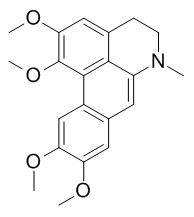Dehydroglaucine
Dehydroglaucine is an acetylcholinesterase inhibitor, it shows antimicrobial activity against Staphylococcus aureus, Mycobacterium smegmatis, Candida albicans, and Aspergillus niger.
Inquire / Order:
manager@chemfaces.com
Technical Inquiries:
service@chemfaces.com
Tel:
+86-27-84237783
Fax:
+86-27-84254680
Address:
1 Building, No. 83, CheCheng Rd., Wuhan Economic and Technological Development Zone, Wuhan, Hubei 430056, PRC
Providing storage is as stated on the product vial and the vial is kept tightly sealed, the product can be stored for up to
24 months(2-8C).
Wherever possible, you should prepare and use solutions on the same day. However, if you need to make up stock solutions in advance, we recommend that you store the solution as aliquots in tightly sealed vials at -20C. Generally, these will be useable for up to two weeks. Before use, and prior to opening the vial we recommend that you allow your product to equilibrate to room temperature for at least 1 hour.
Need more advice on solubility, usage and handling? Please email to: service@chemfaces.com
The packaging of the product may have turned upside down during transportation, resulting in the natural compounds adhering to the neck or cap of the vial. take the vial out of its packaging and gently shake to let the compounds fall to the bottom of the vial. for liquid products, centrifuge at 200-500 RPM to gather the liquid at the bottom of the vial. try to avoid loss or contamination during handling.
Analytical Methods2018, 10(27)
Front Pharmacol.2023, 14:1244655.
Biotechnology and Bioprocess Engineering2024, 29:1048-1060.
Bioorg Chem.2024, 145:107182.
Srinagarind Medical Journal2019, 34(1)
Int J Biol Sci.2023, 19(10):3077-3098.
Antioxidants (Basel).2023, 12(12):2131.
Inflammation.2021, doi: 10.1007
Curr Res Virol Sci.2022, 3:100019.
Antibiotics (Basel).2024, 14(1):8.
Related and Featured Products
Journal of Pharmaceutical Sciences, 1975, 64(5):789-792.
Two antimicrobial alkaloids from heartwood of Liriodendron tulipifera L.[Reference:
WebLink]
Alcoholic extracts of the heartwood of Liriodendron tulipifera have demonstrated antimicrobial activity against Staphylococcus aureus, Mycobacterium smegmatis, Candida albicans, and Aspergillus niger.
The antimicrobial activity was associated only with the alkaloidal fraction.
METHODS AND RESULTS:
Separation of the active alkaloidal fraction by chromatography led to the isolation and identification of Dehydroglaucine and liriodenine as the active components.
CONCLUSIONS:
Several other alkaloidal derivatives were prepared and tested. In addition to the active alkaloids, michelabine was also identified in the tertiary nonphenolic base fraction along with the lignan, lirioresinol-B-dimethyl ether, and two N-acetylnoraporphine alkaloids from the nonbasic fraction.
RSC Adv. 2016, 6(100):98476-98486.
Zeolite based solid-phase extraction coupled with UPLC-Q-TOF-MS for rapid analysis of acetylcholinesterase binders from crude extract of Corydalis yanhusuo.[Reference:
WebLink]
A very convenient, sensitive and precise solid-phase extraction approach was established for extract and analysis of acetylcholinesterase binders from crude extract of Corydalis yanhusuo.
METHODS AND RESULTS:
This approach was based on the retention of binders by acetylcholinesterase immobilized zeolite. The retained acetylcholinesterase binders were eluted and analyzed by ultra-high performance liquid chromatography and quadrupole-time-of-flight mass spectrometry. The powder X-ray diffraction (XRD), transmission electron microscopy (TEM), and Fourier transform infrared (FT-IR) spectroscopy techniques were employed for the characterization of acetylcholinesterase immobilized zeolite. Some experimental conditions such as incubation temperature, time, buffer pH and ion strength, which may affect binding capability, were investigated by using coptisine as a model inhibitor. The optimal incubation conditions were as follows: wash times: 4, wash solvent: 50% methanol-water, incubation time: 20 min, temperature: 37 °C, ion strength: 10 mM, pH: 7.4. The proposed approach was successfully applied for the extraction of acetylcholinesterase binders from crude extract of Corydalis yanhusuo. These binders were further validated by acetylcholinesterase inhibitory assay.
CONCLUSIONS:
Fourteen acetylcholinesterase inhibitors were identified, and ten of which, including dehydrocorydaline, allocryptopine, corydaline, Dehydroglaucine, protopine, tetrahydrocoptisine, tetrahydropalmatine, corynoline, tetrahydrocolumbamne and tetrahydroberberine, were reported for the first time. In addition, the merits and shortcomings of zeolite based solid-phase extraction approach were compared with that of magnetic nanoparticles based solid-phase extraction approach.



